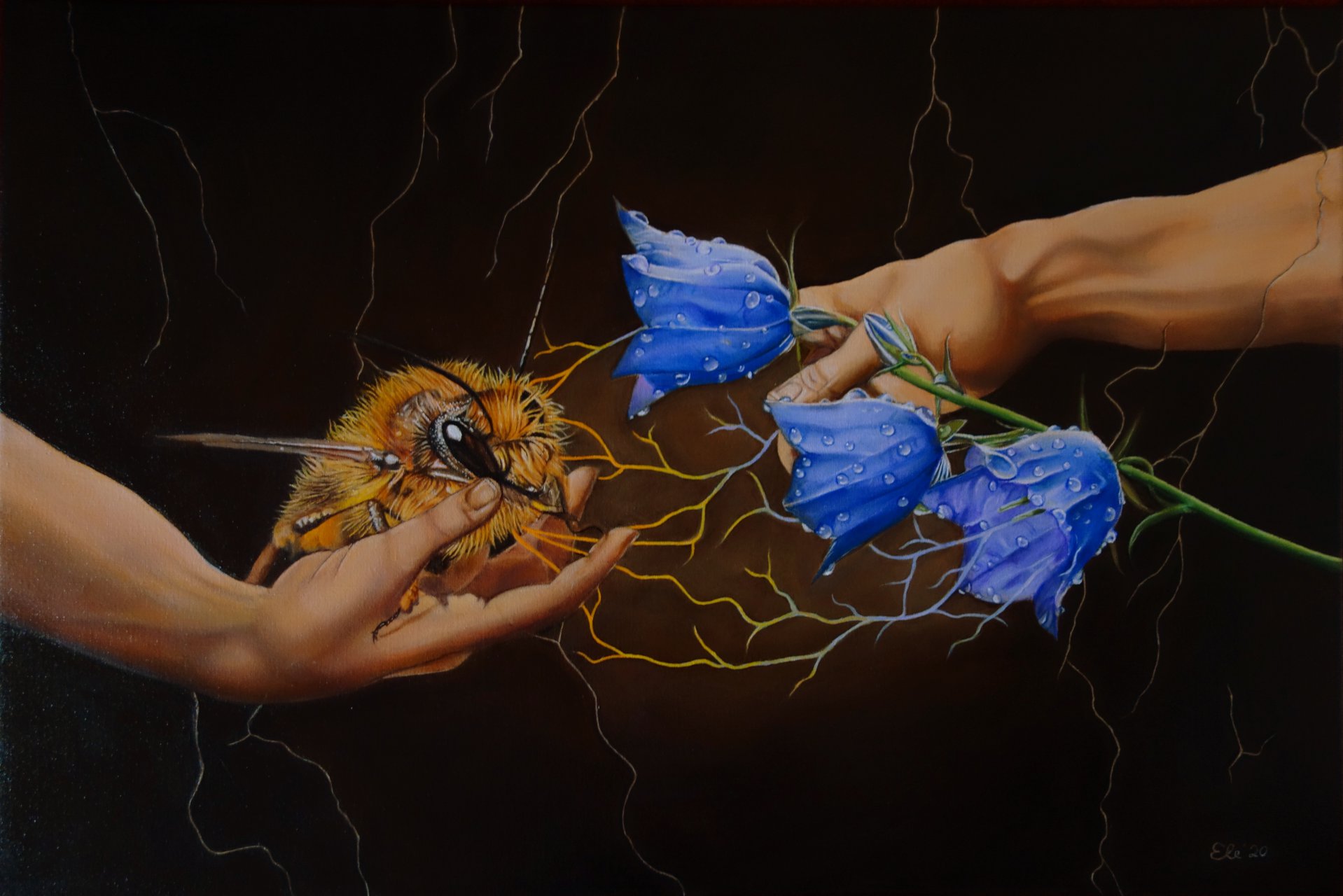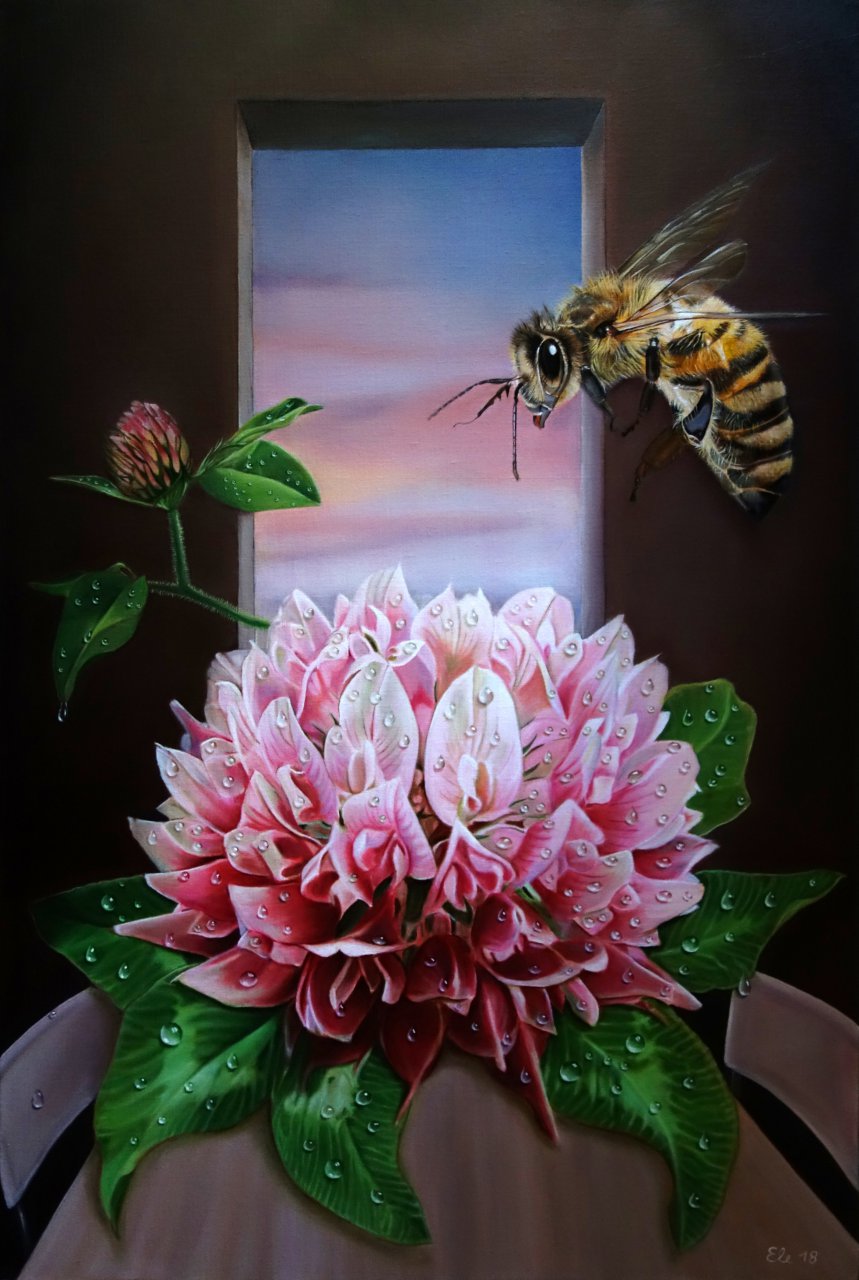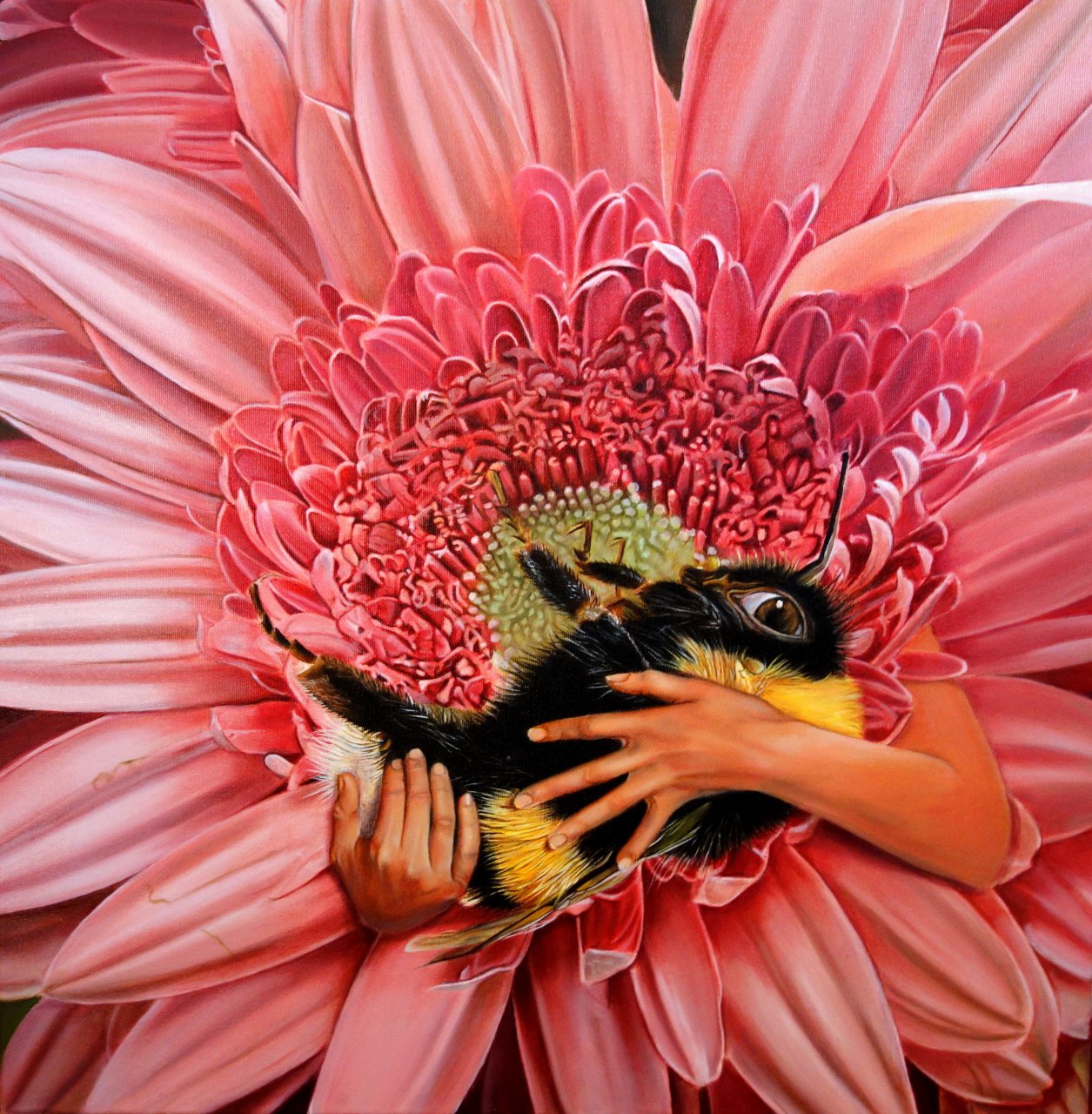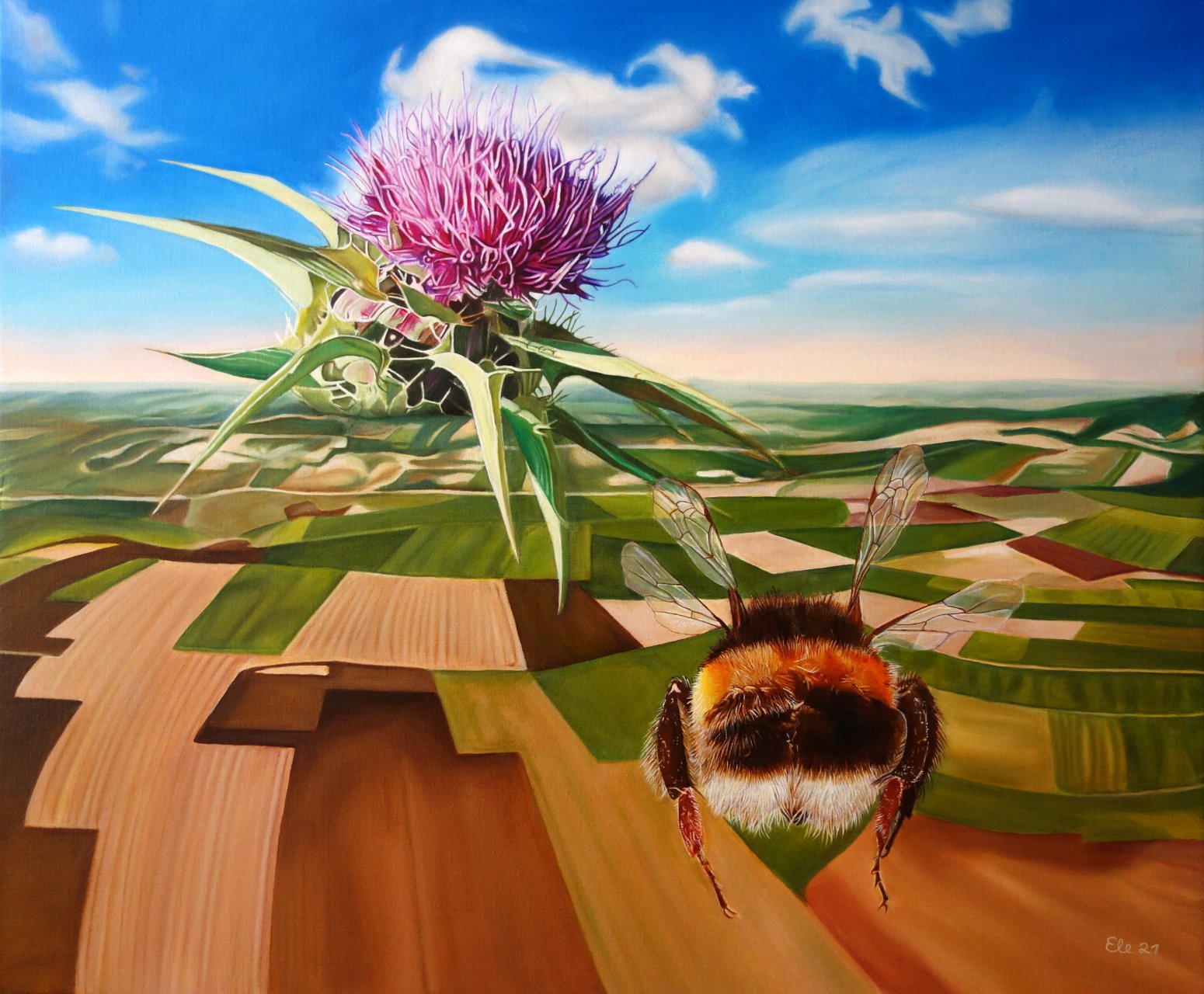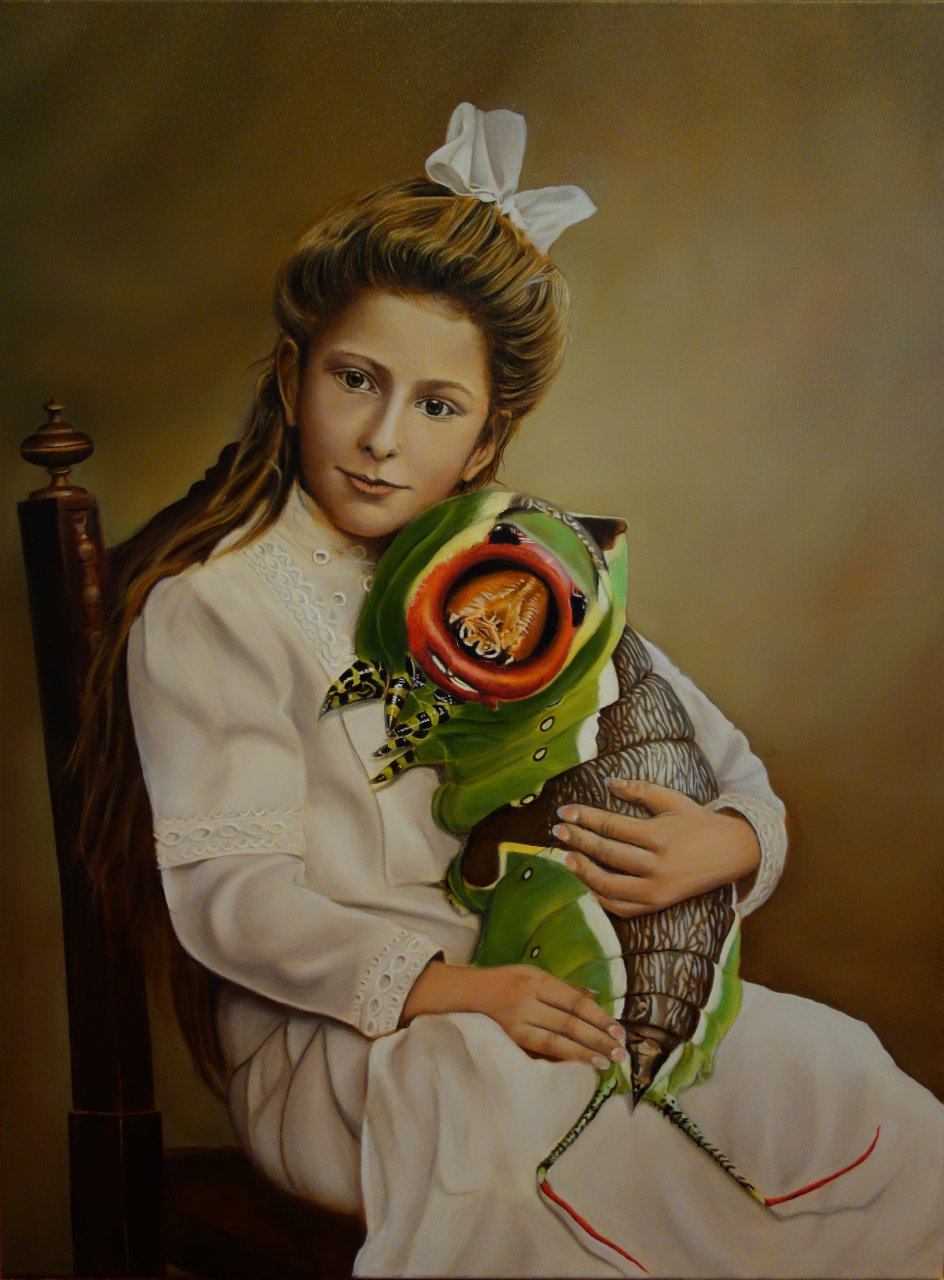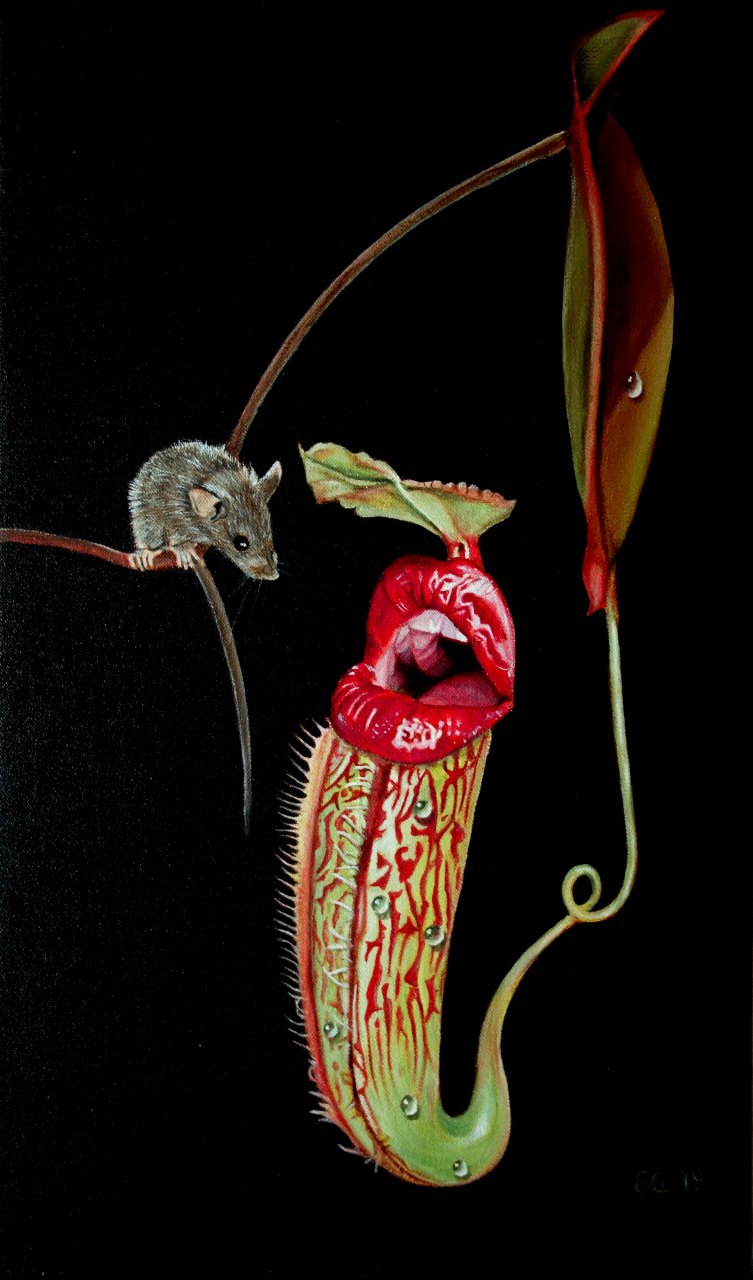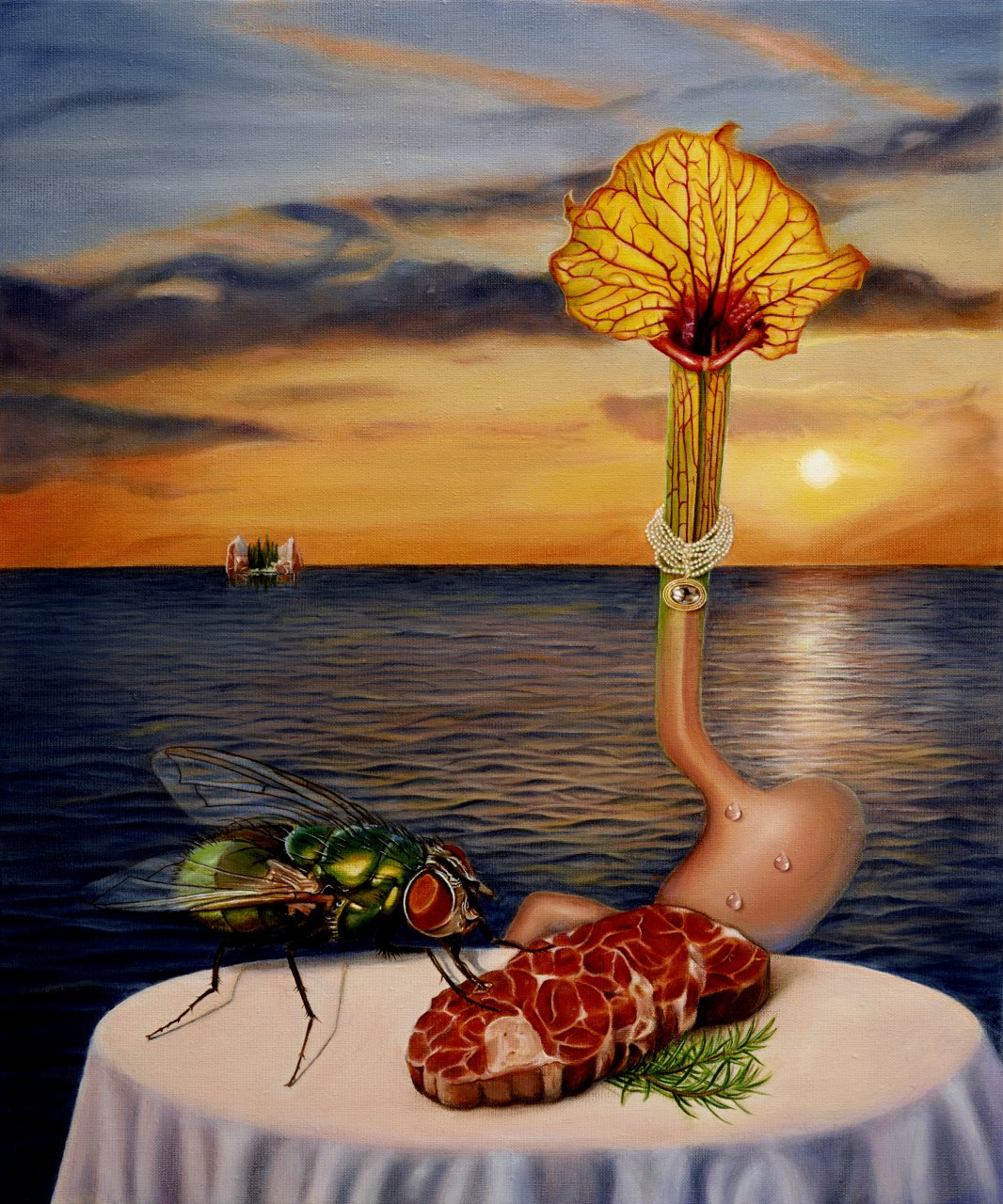 |
||
The Secret - Gabriele Esau
When I found this about 100 years old photo of a little girl, I immediately felt the need to paint it. It, especially its gaze, captivated me.
Looking at the photo, questions arose in me:
Who was/is she?
Is she still alive? (rather unlikely)
What has become of her?
What was her life like? Was it a beautiful life and/or a long life?
I wanted to incorporate the mystery of his life and the secret that the girl carries with her into my painting.
As a symbol for the path of life or the mystery of life and death, I gave him a labyrinth. To be more precise, it is a maze.
The magnolia in the background stands for long life, among other things. The pink blossoms are associated with youth, innocence and joy.
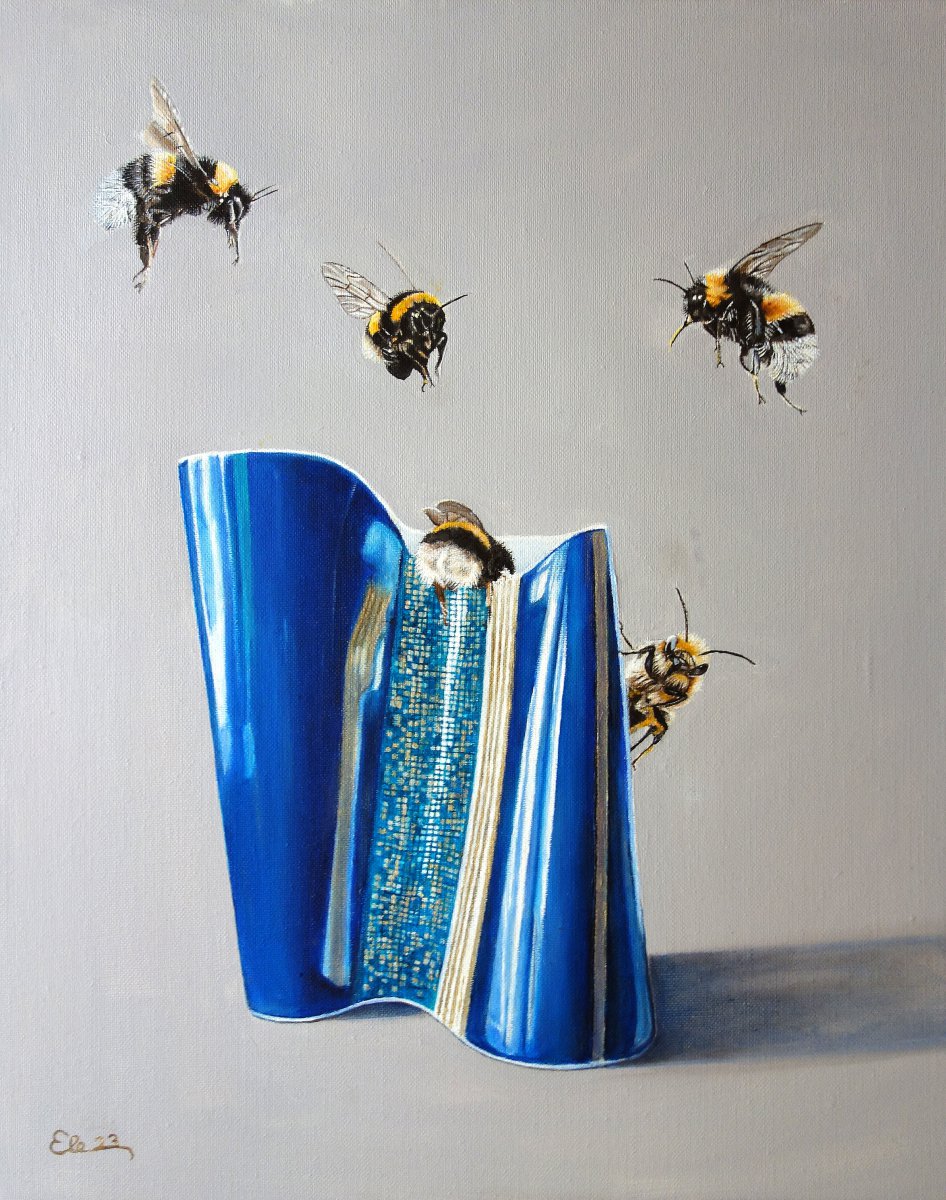 |
||
Looking for Flowers - Gabriele Esau
 |
||
Villa Domenech - Gabriele Esau
Villa Doménech, is a stately home from the early 20th century, located at the entrance to Ondara (Spain, Costa Blanca). It has been abandoned for years and is falling into disrepair.
Because of its ornate floor and plinth tiles, which have commercial value, it has been left to looting and desolation.
The painting shows part of the courtyard of this historic building. A shadow of the past has taken up residence there.
 |
||
The Three Ages of Man and Death - Gabriele Esau
My work "The Three Ages of Man and Death" is inspired by the painting of the same name by the German artist Hans Baldung.
It is an allegory about the transience of beauty and the fragility of human life.
The human figures in Hans Baldung's painting, a young woman, an old woman, death and a baby, are represented here by anthuriums.
 |
||
Woodworkers Gothic - Gabriele Esau
The work "Woodworkers Gothic" is a new interpretation of the well-known painting "American Gothic" by Grant Wood.
The two main figures in Wood's painting were replaced by a pair of stag beetles by me, who have a special fondness for insects.
These are beetles that prefer to live and "work" in the forest. The work title "Woodworkers Gothic" thus not only refers to the stag beetles' way of life, but also establishes a connection to the originator of the original
 |
||
Energy - Gabriele Esau
The painting is inspired by Michelangelo Buonarroti's fresco "The Creation of Adam", which depicts God the Father bringing Adam to life with an outstretched index finger.
Life force is also transferred in the work "Energy". Here, however, the transfer is not directly from hand to hand, but from a plant (bellflower) to a bee. The latter are held by the hands stretching out towards them.
The painting is an allusion to the present situation of the bees. They no longer find enough food to survive. It is therefore necessary to provide them with vital flowers of bee-friendly plants.
 |
||
The Wishing Table - Gabriele Esau
Bees are increasingly losing their habitat and food source due to monocultures and the use of pesticides.
The painting "The Wishing Table" (Lay a table) shows how we can help the bees by offering bee-friendly flowers. Here, a bee has found a table laid for it, adorned with a large clover that is dotted with drops of water to quench its thirst.
 |
||
Nursing - Gabriele Esau
The work points out the current situation of the bees and shows how humans can support the flower pollinators by giving them flowers.
The connection of flower with human arms holding a bumblebee illustrates our dependence on each other.
 |
||
Flying to the promised Land - Gabriele Esau
In a landscape characterised by monoculture, bees do not find a sufficient and varied food supply, so that they are partly responsible for bee mortality.
In this work, the bee sets out for a better world, with an abundant food supply, symbolised by an oversized thistle on the horizon.
The bee flies to the promised land.
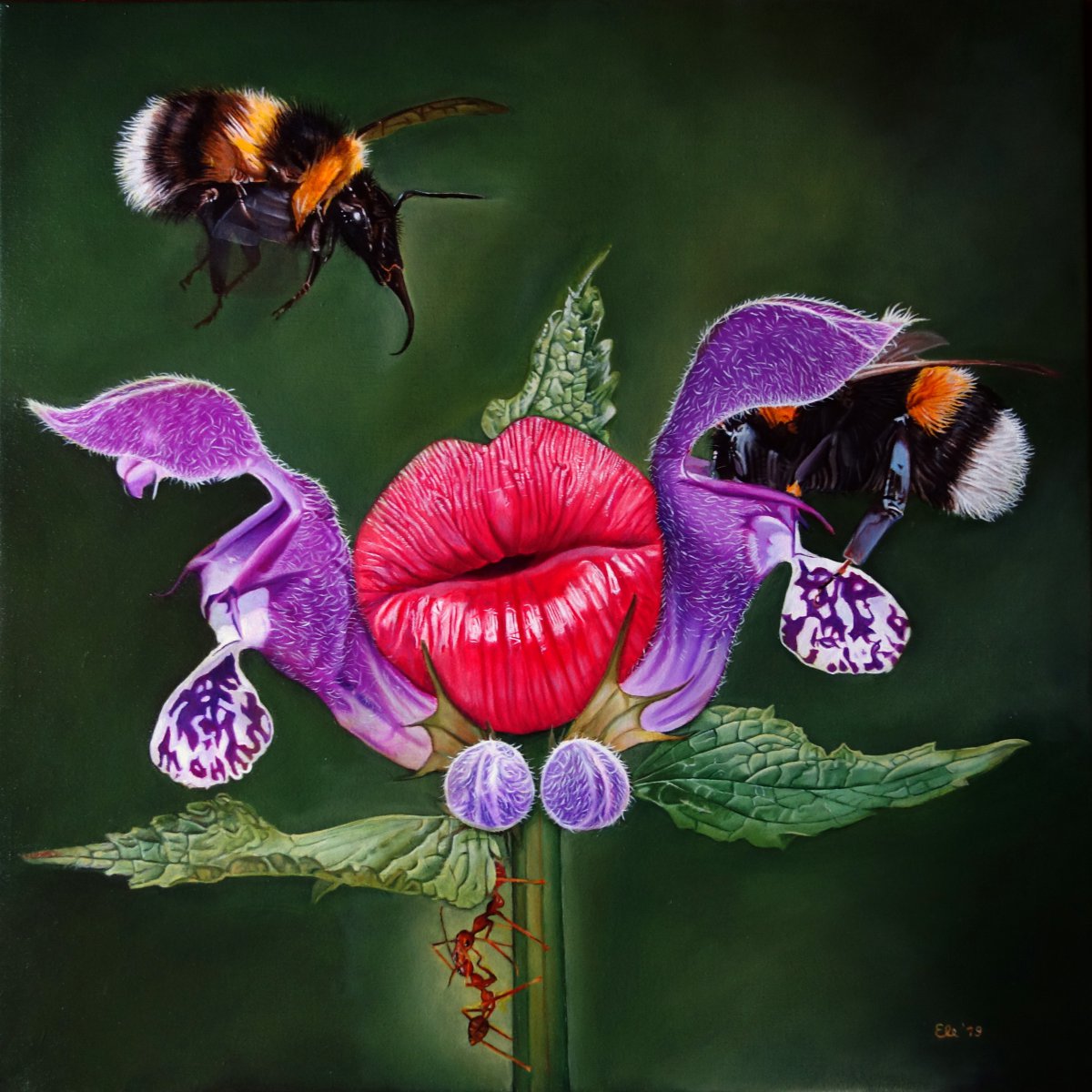 |
||
Kisses - Gabriele Esau
"Kisses" is part of my series, which deals with the protection and care of bees.
My painting shows a bee-friendly plant, the colored nettle, which belongs to the family of the labiates. The bees and bumblebees love them and the plant also needs these insects, just like we humans. We all need each other and I emphasized this togetherness by inserting human, kissing lips. For the love of nature.
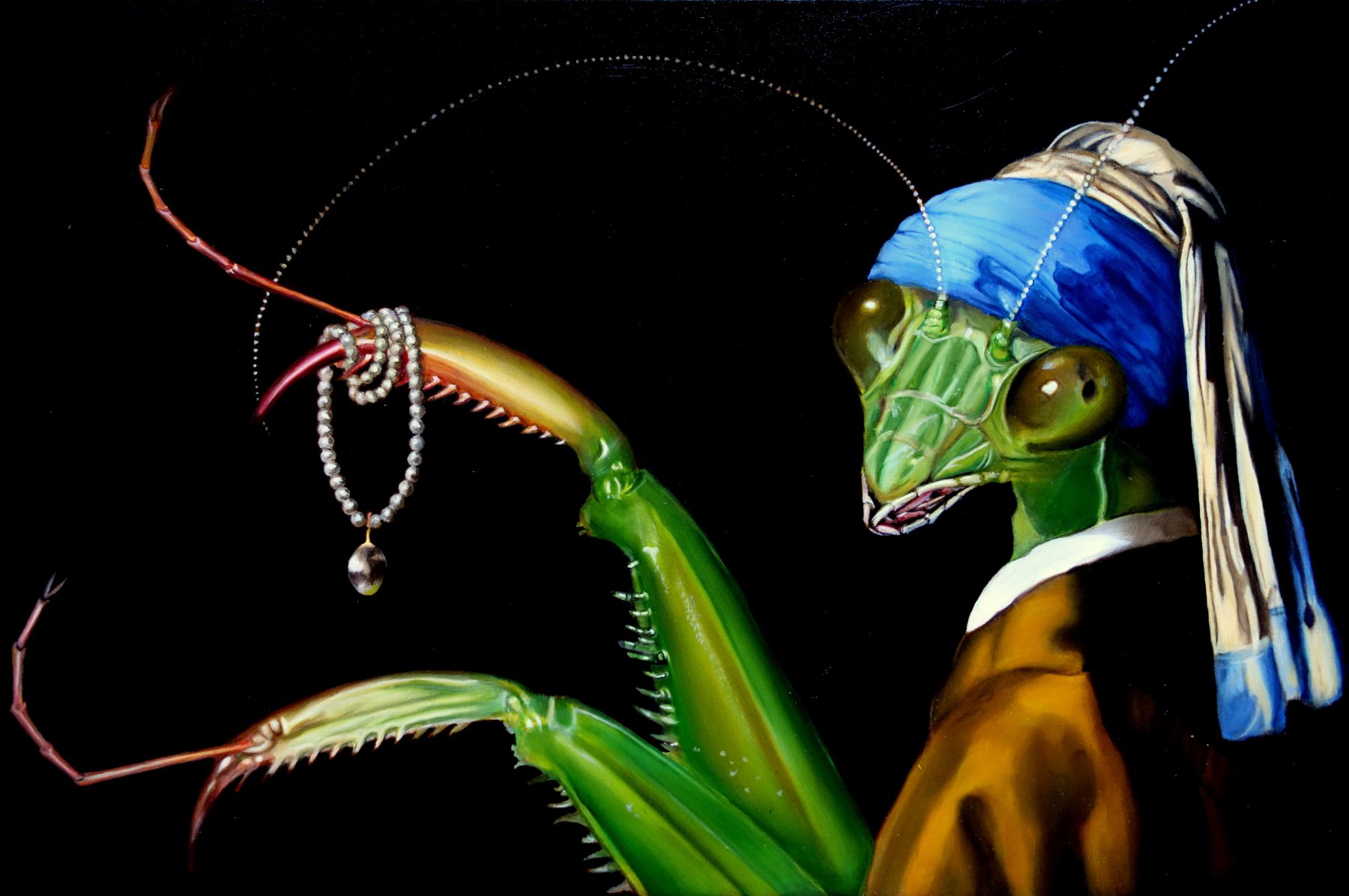 |
||
The Girl with Pearl Eyes - Gabriele Esau
The work of Jan Vermeer van Delft "The Girl with the Pearl Earrings" served as inspiration for the surreal painting.
The girl, here represented by a praying mantis, already has eyes so large, that they are compared to pearls.
She holds the pearl from the earring of the original painting on a chain in her tentacles.
 |
||
Du fehltest mir / I missed you - Gabriele Esau
 |
||
Babysitter - Gabriele Esau
The stag beetle is a rare forest dweller that is now considered critically endangered.
The reason for this is the loss of suitable habitats, especially breeding sites.
For their development, the larvae need deadwood, including logs and stumps.
The work shows a girl holding the pupa of a stag beetle, symbolic of its protection.
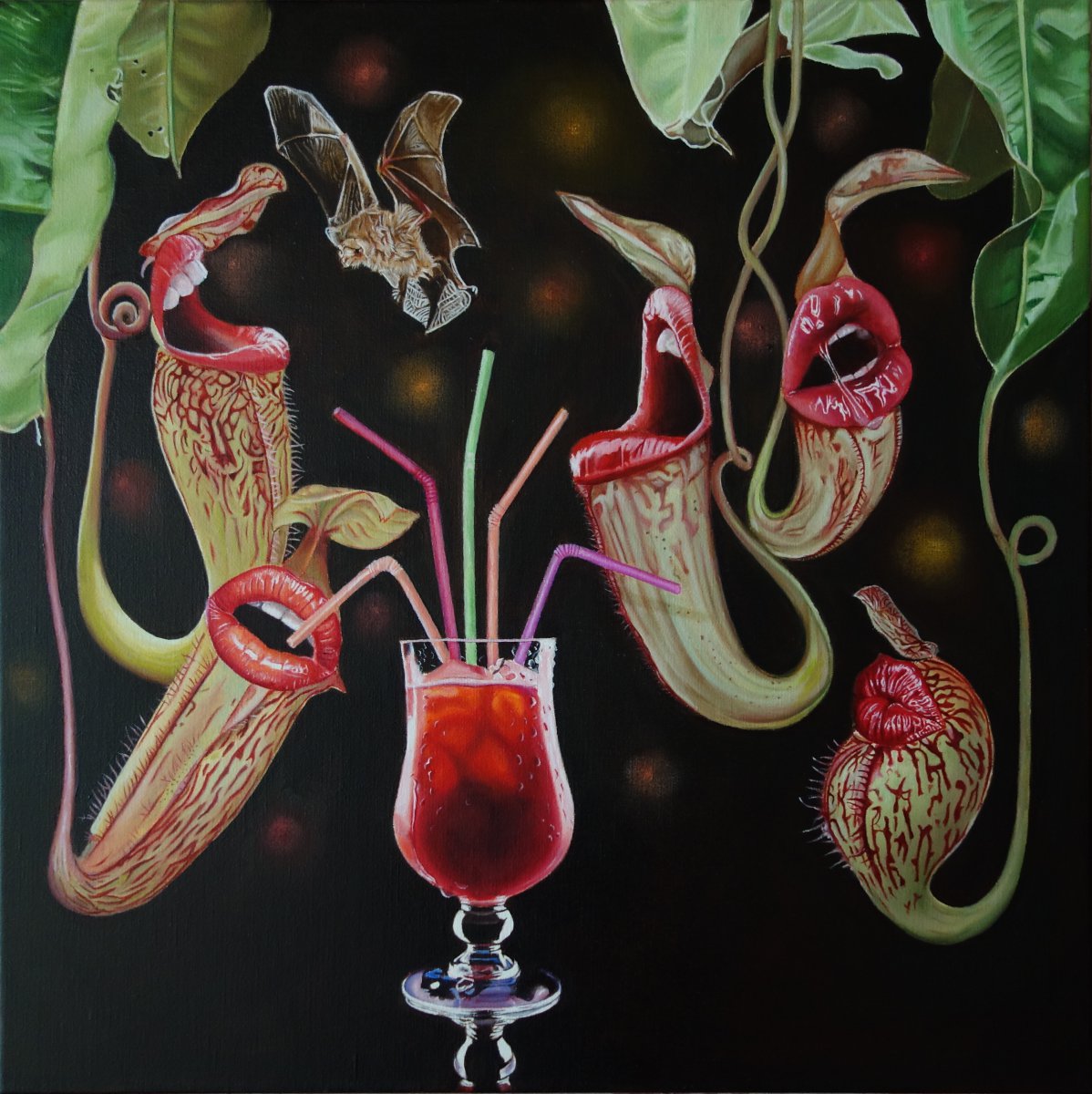 |
||
Ladies Night - Gabriele Esau
The encounter with pitcher plants is often fatal for insects and other small animals, because they are carnivorous plants.
In my painting "Ladies Night" I presented the pitcher plants as femme fatales, which celebrate an exuberant cocktail party. They vie for the favor of a bat that often seeks shelter in the pitchers and lives with them in a community.
 |
||
Femme fatale - Gabriele Esau
In my paintings, I often humanize plants by combining them with human body parts. In this work I gave the carnivorous pitcher plant Nepenthes feminine sexy lips to make it a femme fatale. In fact, the encounter of small creatures with this attractive plant usually ends fatally and they find death if they get into the pot.
 |
||
Venus - Gabriele Esau
This work is inspired by the painting "Birth of Venus" by the Italian painter Sandro Botticelli.
A Venus - flytrap with the eyes of Sandro Botticelli's Venus, swarmed by flies. This has already been the undoing of one fly
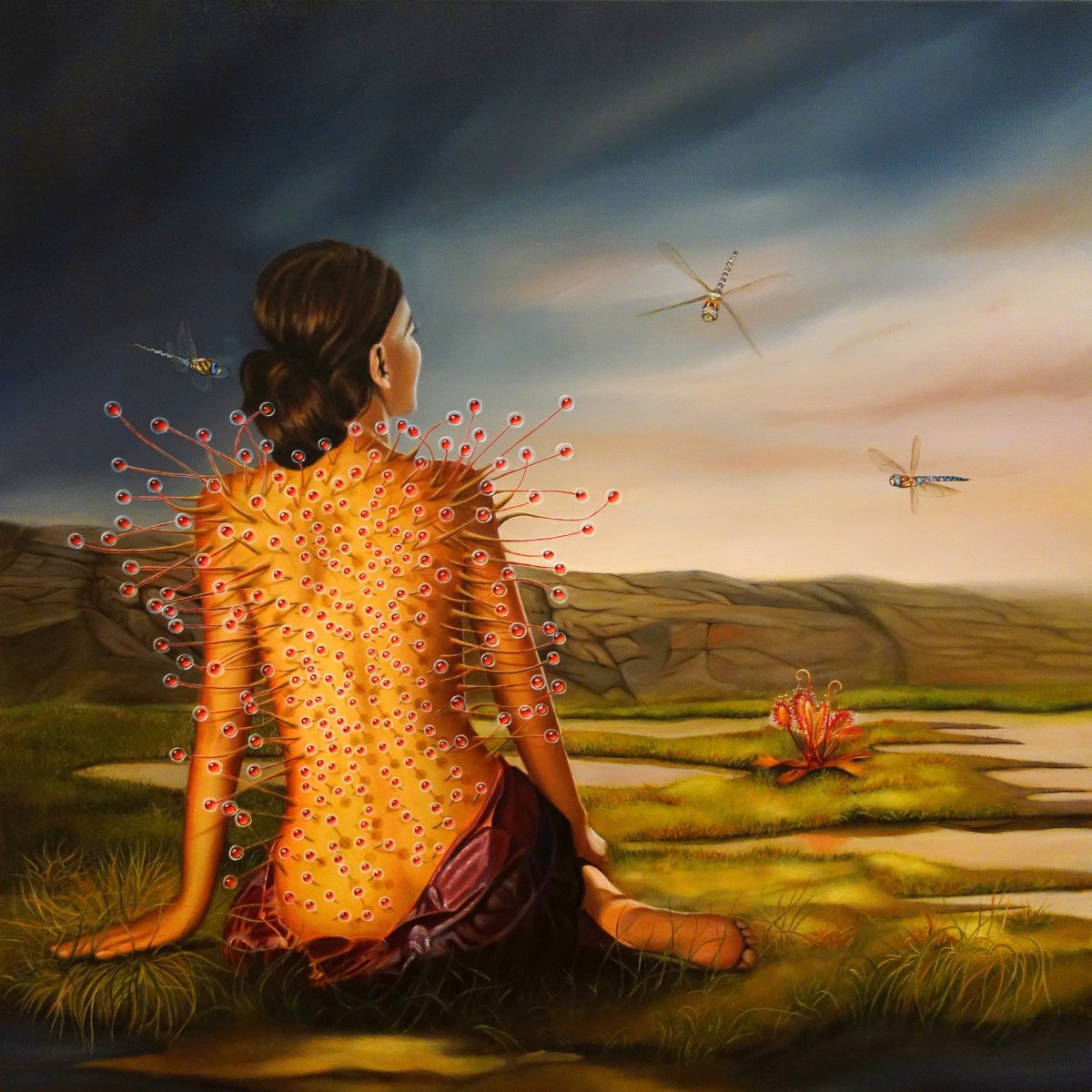 |
||
Drosera - Gabriele Esau
Drosera is a carnivorous plant that is considered endangered in many places due to habitat loss (drainage, peat cutting). Its small, low growth and relatively inconspicuous appearance also mean that it is easily overlooked. I was keen to show this often hard-to-recognise plant in its actual beauty. In order to draw attention to the initially inconspicuous plant, the Drosera was painted in oversized form and with the body of a woman, from which the glandular tentacles grow. In addition to the plant, the painting also shows the nature-human relationship, which forms a unity through the fusion of man and plant.
 |
||
Dinner for Two - Gabriele Esau
A dinner shared by two meat lovers, a fly and a Sarracenia.
 |
||
Isle of Death - Gabriele Esau
The painting is a new interpretation of the work of the same name by Arnold Boecklin.
 |
||
Banquet of shimmering Personalities - Gabriele Esau
The work shows a fine society that has gathered at a table for a feast. The participants are blowflies, whose bodies shimmer metallically due to their blue, green to golden-green glossy colouring. While this sheen exudes a certain fascination, these insects share a fondness for odorous, decaying organic matter, such as carrion. In summary, the dazzling personalities gathered at the banquet can also be briefly described with the saying: "More appearance than reality". Appearance in this context is the external impression that cannot always be relied upon. Being, on the other hand, is the assured fact.
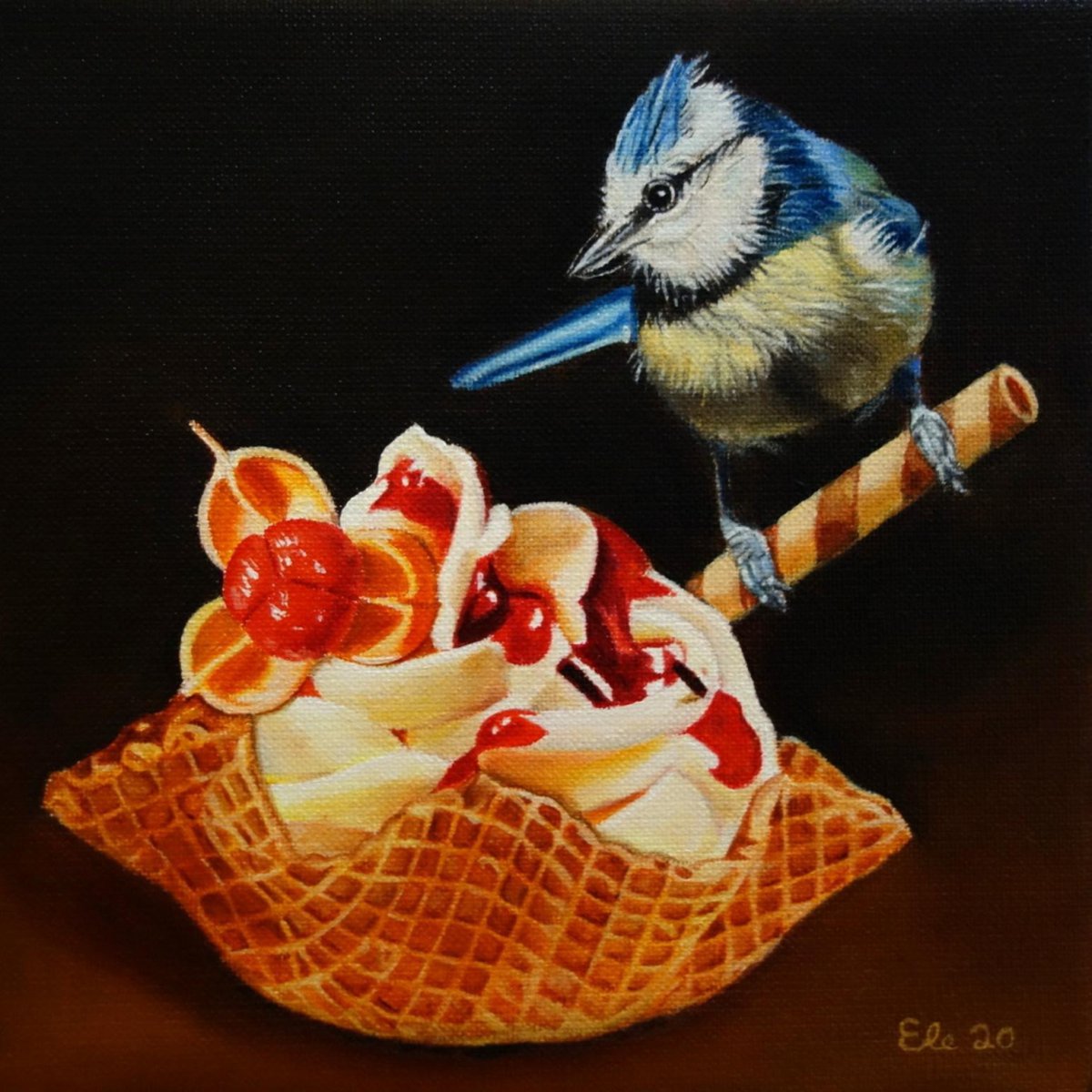 |
||
Series Bittersweet / Bittersweet - Gabriele Esau
With a mixture of realism and fantasy, ambivalent emotions are depicted, as well as the taste of bitter and sweet elements. The painting is dedicated to the extraordinary year 2020. The Corona pandemic and the measures taken to contain it have led to a variety of effects and consequences. They were largely bitter, but also sweet.
The name of the plant bittersweet comes from the change in taste that one perceives when chewing the parts of the plant. The initially bitter taste is replaced by a sweet taste. The plant, which is poisonous to humans, is well tolerated by birds. Its fruits are a valuable source of food for them in autumn.
 |
||
Fiat 500 - Strawberry cream - Gabriele Esau
Today, the Fiat Cinquecento enjoys a cult status similar to that of the Beetle, Duck or Mini.
The spherical little car has always attracted people to cosy names such as little mouse, little box and little ball.
The Fiat 500's affectionate designation as a cream puff was taken literally here.
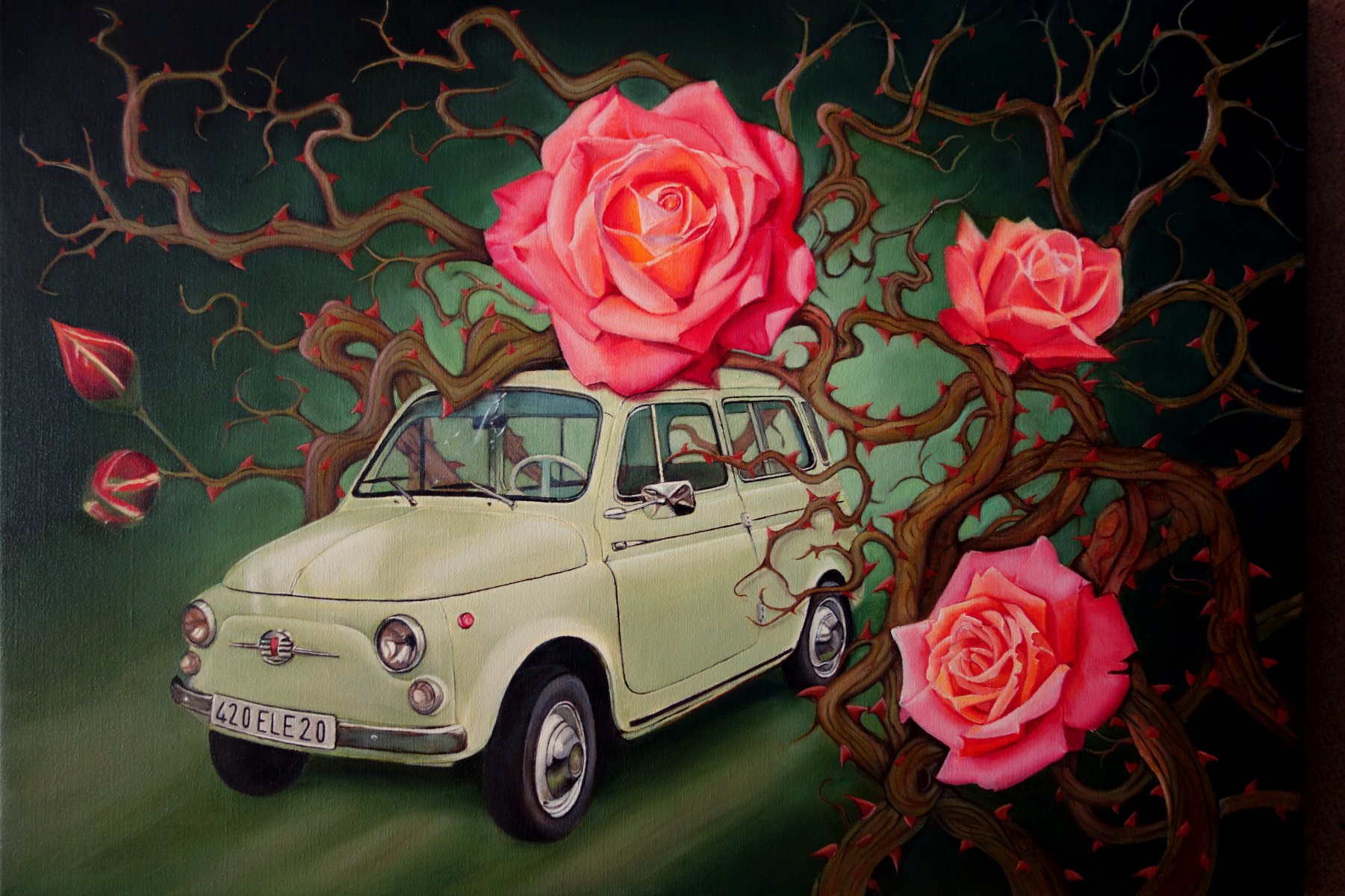 |
||
Fiat 500 Giardiniera - Sleeping beauty - Gabriele Esau
The inspiration for this work came from a collector of old Fiat models, who brings these charming vehicles, long abandoned and little noticed, back to life through restoration.
As a result of the acquaintance with this classic car lover, a Fiat 500 Giardiniera awakening from its Sleeping Beauty slumber has been created.
 |
||
Catlick - Gabriele Esau
A catlick or cat wash is the colloquial term for a quick, not very thorough wash that barely comes into contact with water.
This expression, which does not do justice to the clean cats, was taken literally and depicted figuratively in the work "Catlick".
A washing machine can be seen with a cat's tongue sticking out of it. It is located on a long, remote road and offers travellers a quick wash (Quickwash) in exchange for money.
 |
||
Yellow horned Poppy / The Visitor - Gabriele Esau
Always on the lookout for beauties from the animal and plant world, I came across the yellow horned poppy on the
on a Mediterranean beach (Costa Blanca) in spring.
I was doubly lucky, because the bright yellow plant had just been visited by a shiny metallic green beetle.
a shiny metallic green beetle called the Spanish fly.
Back at home, I wanted to relive the impressions of the spring beach and
and enlarged her beautiful encounter onto the canvas.
 |
||
Palm Shadow - Gabriele Esau
A very small section observed and captured in a very brief moment was worth capturing later in a larger format.
The painting shows a detail of a trunk with its fascinating surface structure. The shadow cast by a palm frond reveals that it belongs to a palm tree.
 |
||
Strelitzie - Gabriele Esau
The painting shows a detail of the stem of a strelitzia.
The strelitzia is best known for its bright flowers with their unusual shape. These earned the plant the name "parrot flower", among others.
Less attention is paid to its trunk with its fascinating surface structure, which is the focus of this work.


















